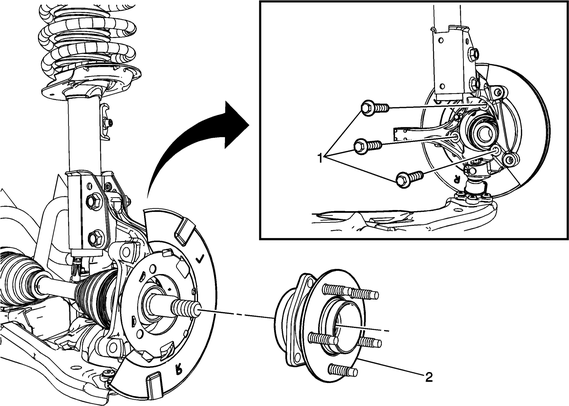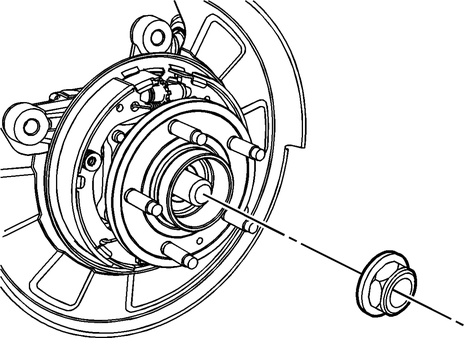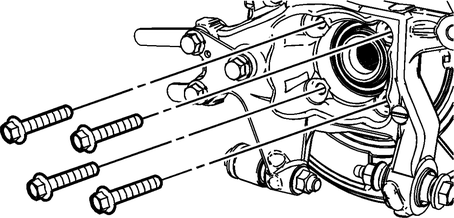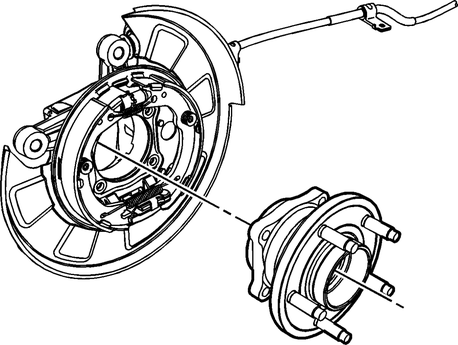Chevrolet Captiva Service & Repair Manual: Wheel Hub & Bearing Assembly R&R
Front
| Allow threadlocker to cure approximately
10 minutes before installing front wheel bearing and hub assembly bolts. |
| 1. |
Separate front wheel drive shaft at
front wheel bearing and hub assembly. |
| 2. |
Remove front brake rotor. |
| 3. |
Remove front wheel speed sensor at
steering knuckle. |
| 4. |
Remove front wheel bearing and hub
assembly bolts, Fig. 1. |
| 5. |
Thoroughly clean old threadlocker residue
from threads of each front wheel bearing and hub assembly bolt with
an approved solvent and allow to dry. |
| 6. |
Thoroughly clean old threadlocker residue
from each front wheel bearing and hub assembly bolt hole with an
approved solvent and allow to dry. |
| 7. |
Apply threadlocker to 2/3 of threaded
length of front wheel bearing and hub assembly bolts and front wheel
bearing and hub assembly bolt holes. |
| 8. |
Ensure there are no gaps in threadlocker
along filled area of front wheel bearing and hub assembly bolts
and front wheel bearing and hub assembly bolt holes. |
| 9. |
Reverse procedure to install. Torque
front wheel bearing and hub bolts to 96 ft. lbs. |
|
Rear
| Splash shield and park brake assembly
are supported to knuckle between wheel bearing mounting bolts and wheel
bearing. Care should be taken to support these items while wheel bearing
is being replaced. |
| 1. |
Raise and support vehicle. |
| 2. |
Remove rear tire and wheel assembly. |
| 4. |
Remove wheel speed sensor. |
| 5. |
On models equipped with All Wheel
Drive (AWD), remove rear wheel driveshaft nut, Fig.
2. |
| 6. |
On all models, remove four wheel
bearing bolts, Fig. 3. |
| 7. |
Remove wheel bearing from knuckle,
Fig. 4. |
| 8. |
Reverse procedure to install, noting
following: |
| |
a. |
Torque wheel bearing and hub
bolts to 55 ft. lbs. |
| |
b. |
Torque rear wheel driveshaft
nut to 151 ft. lbs. |
|

Fig.
1

Fig.
2

Fig.
3

Fig.
4
Captiva Sport Repair Manual includes detailed instructions for servicing the wheel hub and bearing assembly, an essential component of the vehicle's suspension and wheel system. The wheel hub and bearing assembly play a crucial role in supporting the vehicle's weight and facilitating smooth rotation of the wheels. Over time, wear and tear or damage can occur, necessitating inspection, maintenance, or replacement of these components.
The repair manual outlines step-by-step procedures for safely removing the wheel hub and bearing assembly from the vehicle. This includes loosening and removing wheel nuts, disconnecting brake components and ABS sensors if applicable, and carefully extracting the assembly from the wheel hub.
The article provides guidance on inspecting the wheel hub and bearing assembly for signs of wear, damage, or improper function. Common issues such as noise, vibration, or wheel play may indicate a need for servicing or replacement of these components.
Proper maintenance and servicing of the wheel hub and bearing assembly are essential for ensuring safe and reliable vehicle operation, smooth wheel rotation, and optimal handling and steering performance. 2018 Captiva Service manual provides comprehensive instructions and guidelines for addressing issues related to these critical components, helping vehicle owners and technicians perform necessary repairs or replacements effectively.
1.
Raise and support vehicle.
2.
Remove tire and wheel.
3.
Remove park brake cable bolt from trailing
arm an ...
Suspension fasteners are critical
components because they affect performance of vital components and systems
and their failure may result in major service expense. New components must
...




 Trailing Arm R&R
Trailing Arm R&R Wheel Lug Stud R&R
Wheel Lug Stud R&R